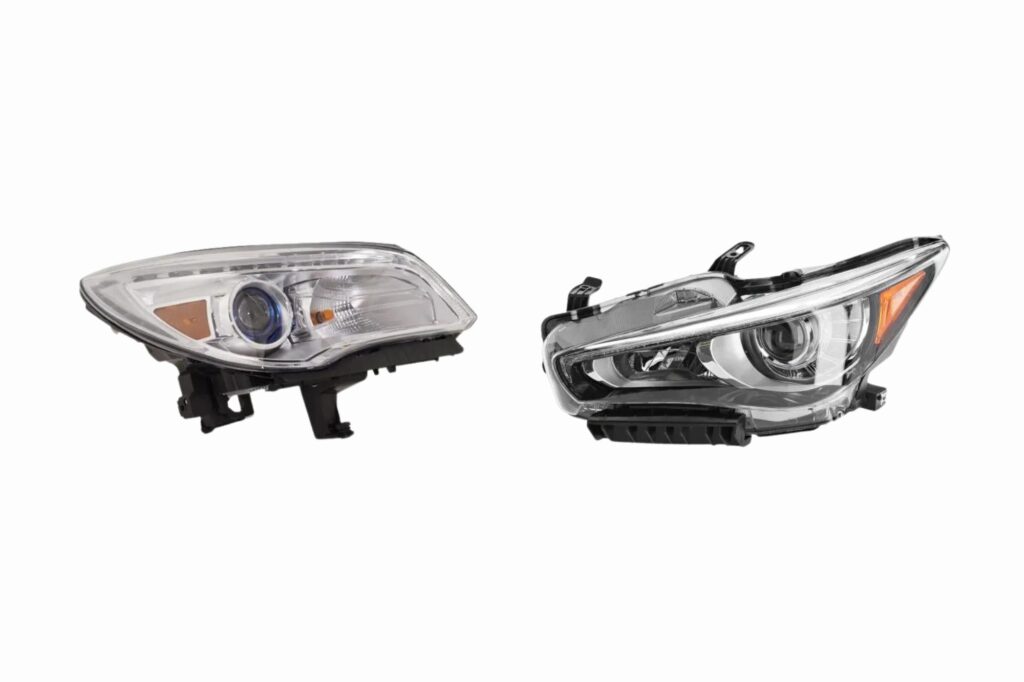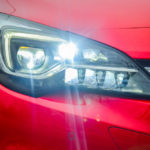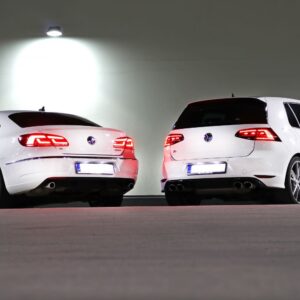If your headlights are dim, flickering, or not working, you’ll have a hard time seeing the road ahead at night and other low-visibility conditions. Fortunately, more often than not, fixing this problem is just a matter of replacing a faulty light bulb.
You can get the same type as your stock headlight bulb, but if you’re looking to change it up a bit, you can consider installing a different kind.
There are halogen lights, the simplest and most commonly used, and laser headlights, the most expensive and technologically advanced. But for this article, we’ll focus on HID and LED headlights, which are incredibly popular among gearheads and manufacturers alike.
What’s the Difference Between HID and LED Headlights?

High-intensity discharge (HID) headlights are also referred to as xenon lights because their bulbs have two electrodes inside a glass enclosure filled with xenon gas. Xenon is a specialized light source that produces a blue glow.
On the other hand, light-emitting diode (LED) headlights produce a bright white light by passing electricity through semiconductors that emit photons.
Here are their key differences at a glance:
- LED lights are brighter yet more energy-efficient than HID lights.
- LED lights last longer than HID lights.
- HID lights use xenon gas, while LED lights rely on electricity.
- HID lights are usually projector lights with a lens that works like a magnifying glass to increase their brightness. Meanwhile, LED lights are typically reflector lights. The steel bowl that surrounds the bulb works like a mirror, reflecting the light outward.
- Some HID lights emit a glare, while LED lights don’t.
- HID lights take a few seconds to light up, while LED lights activate immediately.
- HID lights are more affordable than LED lights.
Which One Should You Choose?
It depends on your needs and preferences.
If you’re looking for a more affordable upfront purchase with more flexibility and the possibility of customization, then HID is the way to go.
On the flip side, LEDs are slightly preferred by automakers and manufacturers because they have better longevity, are brighter, and consume less energy. Not to mention that they don’t cost as much to maintain.
If you’re still not sure which to pick, taking a closer look at the advantages of each type should help.
Advantages of HID Headlights
HID headlights are generally less expensive and have more color options compared to LED.
Less Expensive
HID bulbs are less expensive, with 100W HPS lights (a type of HID bulb) ranging from $5 to $10. LED lights, on the other hand, cost somewhere between $10 and $20. However, both types could cost more, depending on the brand.
More Color Options
HID headlights are available in different colors because manufacturers use different mixtures of metal salts. Different metals produce diverse colors, with lithium producing magenta red-pink, potassium illuminating a lilac-like hue, and more.
Meanwhile, LEDs typically only come in four colors: white, blue, yellow, and purple.
However, while having headlights with custom colors is a great way to make your ride stand out, it could also limit the areas you can drive in. Some states are particular about headlight colors. For example, California only allows yellow and white headlights.
You can still use customized-colored HID headlights, granted you don’t take the vehicle out on the road or highway.

Advantages of LED Headlights
Compared to HID headlights, LED ones consume less energy, are typically brighter, use the latest technology, and have better longevity.
Consumes Less Energy
LED bulbs are slightly more efficient than HID headlights because they need less energy to produce the same amount of light as HID.
They also require less electrical energy to draw out the same amount of light, making them consume less fuel for vehicles and reducing the strain on their electrical system.
Brighter
Lumen rate refers to the unit of space where a headlight illuminates. One lumen is equal to the light source of one candle. LED headlights produce up to 4,000 lumens, which is more than the 3,500 lumens illuminated by HID lights.
LEDs are also glare-free, unlike HIDs. This makes them more dependable during adverse weather conditions or at night when approaching drivers could get their vision momentarily impaired.
Uses the Latest Technology
One could argue that LED headlights are more modern than HID because they’re more commonly used in newer vehicle models. The technology used in LED lights is also more innovative and functional, especially since they use electricity instead of gas.
Better Longevity
As mentioned, LED headlights tend to last 20,000 hours compared to HIDs 5,000 hours. They’re also less prone to damage and are generally more durable because they don’t have as many moving parts compared to HID bulbs.
Easier to Diagnose
HID lights are more complicated and harder to diagnose. This makes issues with LED headlights slightly easier to determine.
Where to Get HID and LED Headlights for Your Vehicle
Whether you’re looking for HID or LED headlights, it’s best to get a high-quality one built to last. Lucky for you, CarParts.com has a wide array of headlights for you to choose from.
Our selection of headlights comes as direct-fit replacements for your daily driver. Choose from only the best manufacturers in the industry, and check out securely in a few clicks.
Use our vehicle selector to show headlights that fit your car. Enter your ride’s year, make, and model to filter out the selection. You can also use the search filters to find headlights that match your preferences.
Here at CarParts.com, we want drivers like you to get the best products at the lowest prices. Shop with peace of mind thanks to our low-price and lifetime replacement guarantees.
Shop for high-quality HID and LED headlights today!
Any information provided on this Website is for informational purposes only and is not intended to replace consultation with a professional mechanic. The accuracy and timeliness of the information may change from the time of publication.































Door latch right rear door
Our 2011 Sienna LTD has HID. Sometimes the one of the HID Bulbs turns off after an hr or so. Left or Right, you never know. Thank God one of them stays on, so far. ALSO, the 7 year battery only lasts 4 years, is that related??
Does Carparts.com have a kit to convert this to LED? How much $$$$?